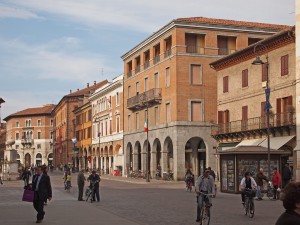Italian culture is arguably the single most important contributor to western civilization. Whether in the arts, sciences, commerce, or even governance (current intrigues, of course, excluded) both the legacies of individual such as Michelangelo, Galileo, Lorenzo De Medici, and Justinian, or the collective influences of the Renaissance and Roman Empire of which they were are part, the Italians' contribution to our way of life is immeasurable and profound. A living testament to this legacy is found in the many fine cites throughout Italy, a few of which form the basis of this series of posts. [caption id="" align="alignnone" width="300"]
Having seen many the cities one typically thinks of when thinking of Italy, my recently completed trip focused on what one may call second (and third) tier cites, in this case mostly in Emilia Romagna. I use the term second and third tier advisedly, for the cities visited are amongst the finest urban environments anywhere, and their lesser notoriety in not a slight to their beauty or charm, merely the lack of recognition of their qualities amongst non-Italophiles.
Visiting Mantua, Ferarra, and Bologna (along with brief stopovers in Modena, Parma, Turin, and Varese) was an opportunity to see a side of Italy unavailable to those whose focus is only on the country's most popular destinations. Unavailable, because those cities are filled not only by their residents, but also throngs of visitors, whose impact on the cityscape is significant. Without the crowds and tour buses, one can arrive at a better sense of how these spaces function on a day-to-day basis -- to see how they function as working cities – and not merely places of leisure. The public spaces visited were filled with the population of the city served, allowing a more tangible measure of their utility and their successes.
[caption id="attachment_1606" align="alignnone" width="300"] Ferrara Streetscape[/caption]
Ferrara Streetscape[/caption]
Italy, of course, was not a nation until 1861, so I use the term Italians not to describe a nation in the contemporary sense, but really the group of people who shared a common language and a common history. Unlike say France, Great Britain, or Spain, there was no country of Italy ruled by a powerful gentry (much of Italy was in fact ruled by foreign powers). What it lacked in national unity it made up for in strong regional identity forged by leading cities, with each being the head of government, commerce, and culture for the region. Each primary city was therefore, a distillation of all of the qualities we identify with modern nation states. We too have cities such as these today: London, Tokyo, Paris, and so on, each the cultural, financial, and governing capital of their nation. What is remarkable about the Italian cities described here, is they achieved comparable levels of greatness in their own time, with populations of maybe 30 to 60 thousands and not millions. This compact size relative to greatness allows an intimate relationship to be forged,, even during a brief sojourn.
[caption id="attachment_1597" align="alignnone" width="700"] Bologna the City of Colonnades[/caption]
Bologna the City of Colonnades[/caption]
Mantua, Ferarra, and Bologna’s origins can be traced back prior to the Roman Empire, though they did not flourish until the late Middle Ages or the Renaissance. In addition to this shared imperial heritage they rose to prominence while ruled by a leading family, whose power came from commerce, banking, or land holding. They were also the seats of bishops. Perhaps it was the concentration of governance (both secular and ecclesiastical) and commerce, and its resulting artistic patronage, which fostered these city-states to greatness. A physical manifestation is to be found within the constructs of the city itself. And even though some grounding in history would help one arrive at a conclusion with greater haste, the observant traveler is bound to come to similar conclusions. The palazzo and duomo fronting the piazza (the traditional market place) is an urban typology typical to almost all cities visited; or, in other-words, both the secular and sectarian seats of power defining the place of public assembly and commerce. Always in the center of the historic city, and always easy to identify by the splendor, size, and regalia of their construction, this logical assembly of edifices imparts to one a knowledge of arrival and of place. With the exception of the duomo, the uses of the buildings may have evolved to our present day, but their function has remained the same: clearly designating a hierarchy of relationships and methods of interaction among the citizenry of the city. And though predictable, there is certainly an abundance of variation within the typology to lend interest to each town visited.

